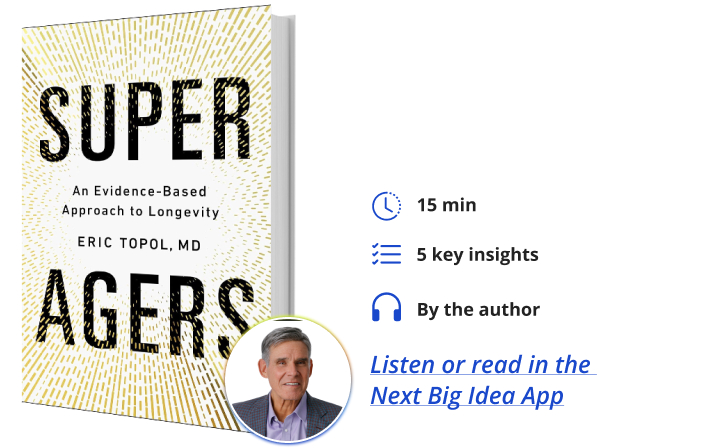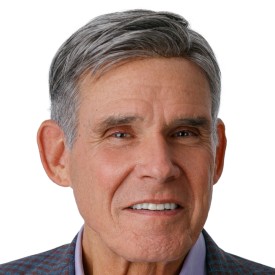Dr. Eric Topol is a physician, practicing cardiologist, and scientist. He is a Professor of Molecular Research and Executive Vice President at Scripps Research, the largest nonprofit biomedical institute in the United States. He is also founder and director of the Scripps Research Translational Institute. He is known for his groundbreaking studies on AI in medicine. He has previously written three books on the future of medicine: Creative Destruction of Medicine, The Patient Will See You Now, and Deep Medicine.
What’s the big idea?
Super Agers is about how to extend your years of aging healthily—your healthspan. There is an intense hunt ongoing to find a magic pill that extends youth, along with a surfeit of predatory pseudoscience, but this book steps away from all that to look specifically at advances in the science of aging that are making the dream of preventing major age-related diseases a reality.
Below, Eric shares five key insights from his new book, Super Agers: An Evidence-Based Approach to Longevity. Listen to the audio version—read by Eric himself—in the Next Big Idea App.

1. The science of aging.
Today, we are seeing many ways to potentially reverse aging, such as reprogramming our cells, drugs that remove senescent cells, the use of supplements like NAD+, medications like rapamycin, lengthening of telomeres, rejuvenating the thymus gland, or preventing ovarian failure. These are just some of the many shots on goal that are aggressively being pursued. However, they each carry significant risks and remain unproven.
But from the science of aging, we have a big new advance: clocks. Specifically, clocks that tell us about our body-wide aging process. This includes epigenetic clocks from a saliva sample, and clocks from a blood sample that help analyze organ quality. Organ clocks can reveal, for instance, if a person’s heart is aging faster than the rest of their body—like a car mechanic discovering everything is working as it should, except for the rear brakes.
2. The big three age-related diseases.
The three major age-related diseases are cancer, cardiovascular, and neurodegenerative. They have many common threads. Each takes at least 20 years of incubation in the body before any symptoms occur. For example, a person with a heart attack must have had ongoing atherosclerosis of the heart arteries decades before the event. Each of these diseases is propelled by our immune system and the untoward release of proteins that rev up inflammation.
“At least 80 percent of heart disease is preventable, as are 40 percent of cancer cases and 45 percent of Alzheimer’s disease and dementia.”
Our medical approach is reactive, meaning we treat the condition but have very little preventative success. At least 80 percent of heart disease is preventable, as are 40 percent of cancer cases and 45 percent of Alzheimer’s disease and dementia. In the book, I present two of my patients who are 98 years old. Mrs. L. R. has never been sick, but all her relatives died in their 50s and 60s (so much for genes having a fundamental role). Mr. R.P. has dealt with heart disease quite successfully, but in the future, it could be prevented.
3. Lifestyle Plus factors.
A big part of primary prevention is what I call “Lifestyle Plus” because it’s not just diet, exercise, and sleep. Those are very important, especially the details of what we eat and how we exercise, but we also need to consider our environmental burden of air pollution, microplastics, and forever chemicals, as well as social isolation, time in nature, and many other factors.
These aspects are tightly intertwined with our modifiable risk of age-related diseases. We don’t necessarily need an expensive magic potion that comes with significant risks. Many habits for a longer healthspan involve only a little cost, awareness, and commitment.
4. Preventing Alzheimer’s disease.
There’s a breakthrough blood test called p-Tau217 that can tell us if a person is going to develop Alzheimer’s. But not just yes or no—it pinpoints when.
The test becomes abnormal more than 20 years before symptoms of cognitive decline and it is modified by exercise and lifestyle factors. We can integrate the many other layers of a person’s data (like clocks, genetics, and blood tests for inflammation) with the help of artificial intelligence to define whether a person is at high risk, and what needs to be done.
“Many habits for a longer healthspan involve only a little cost, awareness, and commitment.”
We can then go into aggressive surveillance mode, performing brain imaging as needed, and may use medications, like GLP-1s (Ozempic Mounjaro, and Zepbound) that are now being tested to prevent Alzheimer’s in people who have no symptoms. Besides lifestyle factors, we have several other new medications in the pipeline.
5. A missing link: the immune system.
The one essential layer of data we don’t have concerns our immune system. After the brain, it’s the most complex system in our body, and there’s no routine blood test that tells us about our exposures to viruses, pathogens, self-directed antibodies, and how our immune cells—such as B and T lymphocytes—are working.
This is essential information because, as we age, our immune response typically gets sluggish, but that varies considerably from one person to the next. And now we have ways to rev up a person’s immune system with medications and vaccines, or alternatively, to tamp it down. Much work is presently being done to go beyond the current “black box” state and make a comprehensive assessment of our immune system a part of routine checkups.
Enjoy our full library of Book Bites—read by the authors!—in the Next Big Idea App:






























